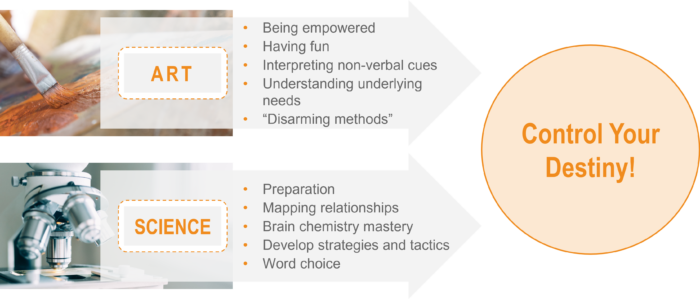Are Negotiations Getting Tougher? Do Something About It!

Sales organizations are dreading necessary conversations every day. Whether pushing through price changes, discussing commercial terms, or wrestling with procurement processes that masquerade as a partnership, sales and commercial teams are constantly making real-time decisions that affect the results of your pricing strategy and your bottom line. While many organizations invest in sales training, sales practices utilize different skillsets than negotiations. Why are so few businesses investing in negotiation training for these vital team members?
For many people, the word “negotiation” can bring an emotional response. However, “dread” is not a winning negotiating strategy. Those with limited negotiation capabilities tend to shy away from having tough but necessary conversations and find themselves giving up more than they would have liked, and getting far less than they deserve.
At INSIGHT, we understand that commercial and price negotiations can play a significant role in a company’s pricing strategy and broader commercial practices. Alternatively, poor negotiations can hinder achieving your growth destiny. This is why we believe negotiation strategies should go far beyond step-by-step tactics and sales training. The most successful businesses combine both the art and science of negotiation and leverage brain chemistry and critical thinking to build a sales team that is empowered to make smart pricing and commercial decisions no matter the scenario.
Why are Price and Commercial Negotiations Important?
The bottom line is price negotiations are important because it affects your bottom line. Realistically, getting just 1% better at negotiating can result in a 10-15% lift in EBITDA in many businesses. In our recent post, Could You Be Leaving Profit on the Table? 4 Best Practices to Increase Price Realization, we discuss how price realization is imperative to profit impact. In reality, you can spend endless time and resources crafting a perfect pricing strategy, but if the customer rejects your price, you’ll never experience your desired results. The true measure of profitability comes from the amount of revenue you actually capture. If this is the case, smart price negotiations are a key factor in increasing price realization and unlocking more profit – all while elevating your customer relationships and exchange of value.
Not only is this concept effective with negotiating price, but also with commercial structures, product mix, and channels to market. If your business adjusts its channel strategy by selling certain products direct versus through a distributor, these types of negotiation conversations are imperative to maintain a necessary and successful relationship with that distributor.
Whether you are formally employing it or not, negotiations occur across the commercial organization all the time through pricing, procurement, and other commercial practices. These negotiations shouldn’t just be about getting a price increase through, but rather about creating a different and better relationship with your customer. Ultimately, it changes the way you commercialize – with your customers, your products and services, your channel mix, and so on.
While employing commercial negotiation delivers exceptional ROI, without it, you leave your business susceptible to high levels of risk in unfavorable macro- and microenvironments. Eventually, your customers may start to reject an aging inflationary storyline and threaten to switch to competitors or lower-cost products. Alternatively, improving negotiation skills empowers your team to thrive in the face of volatility and uncertainty.
What is Price Negotiation?
Internet search results provide an abundance of articles that outline lists of tactics, strategies, and golden rules of negotiation because people want to be better at it. When managing price changes or setting commercial strategies, sales teams woefully anticipate a range of adverse buyer responses they’ve likely heard many times before, such as:
These are representative examples of situations with customers that desire more than you are willing to give, requiring sales teams to be at peak performance with their negotiations by habit. Unfortunately, many commercial organizations find themselves getting less than they deserve and ill prepared to change the balance of power.
In traditional price negotiation situations, there are two independent parties attempting to advance their respective interests, the infamous good-cop bad-cop scenario. We are led to believe the ideal outcome is when both parties have reached a compromise, or a settlement where each side has likely had to concede on something. While we are taught that compromise is good, the underlying truth is that both parties had to give something up. However, optimal price negotiation results in both parties eating from a larger pie, not splitting a smaller one.
This approach aligns with Harvard’s Getting to Yes interest-based principles and philosophies. However, understanding the brain chemistry and science that sits underneath the interest-based discussion is what differentiates a good negotiator from a world-class negotiator.
When done well, price negotiation results in both an improved customer buying experience and increased price realization. It should also generate a desirable cultural shift in your commercial organization. This is because good price negotiation focuses not on mastering a specific set of scripts or tactics to produce a perfect response, but instead mastering your brain chemistry and the way you critically think about and interact with your environment. This approach accepts that there are multiple responses that beget a host of reactions and employs brain science to influence and affect a desired outcome.
In this way, world-class commercial and price negotiations empower a commercial organization to handle any situation they are faced with, instead of memorizing a host of responses and hoping they apply to their given environment.
How to Elevate Your Commercial Negotiation Approach
First, focus on brain chemistry and behavioral changes before the actual negotiation tactics. Gaining control over an outcome begins with combining both the art and science of negotiations.
Next, there are a set of mindsets that, when deployed, better support your ability to leverage the negotiation strategies you have in your toolbox. A handful of these mindsets include:
- Remember Mike Tyson’s insight: Mike’s famous quote, “Everyone has a plan to beat me until I punch them in the face” teaches critical effective negotiating and pushes you to be exceptional at dealing with the theoretical first punch, or the unexpected push-back from those you are negotiating with. This mindset affects how you prepare for meetings and conversations, including learning to listen as much as you talk and understanding that things usually won’t unfold the way you expect them to.
- Know value, like beauty, is in the eye of the beholder: Unlock customer value by understanding the relationship. Nothing is more defeating in a negotiation than showing up with the standard political “stump speech” about the value your offer provides. Instead, your communication should be more intimate and illustrate your mastery of your customer’s business.
- Conflict has an integral role in deepening relationships: Quality relationships are based on intimacy and earned transparency, which require a level of openness to express conflict and agree to pursue mutual interests. Avoiding conflict will lead to transaction-based interactions that feel like you versus them.
- Build peer-to-peer relationships: Because every player at the table has needs, it’s imperative to have a peer-to-peer mindset in the interaction versus constantly looking to please by giving “gifts” (discounts, agreeing to unreasonable requests, remaining silent on non-negotiable items, etc.).
These key mindsets, amongst many others, lay the foundation for more successfully executing commercial and price negotiations. Mastering these will multiply your ability to negotiate and prove to have the greatest ROI of all negotiation tactics available.
While negotiations begin with brain chemistry, there are several smart negotiation strategies that can be utilized once the art and science is understood and practiced. These strategies include:
- Evaluate your commercial and customer relationships
– Conduct detailed health checks by account, including relationship quality, growth potential, and commercial behavior patterns
– Review where long-standing relationships may have gone stale and a fresh approach is required
– Understand your customers’ buying and budgeting decision processes - Build customer scorecards to document need-to-know information
– Understand favorable and unfavorable positions, expected questions and responses, and rank negotiations to offer and ask for
– Explore and document the interests most important to your customers and your business to understand your negotiating landscape - Create a culture that enables ongoing maintenance and growth of negotiation practices
– Build leaders and commercial objectives that support cultures of negotiation (e.g., avoid singular “must win deal” thinking)
Empower Your Team to Win More with Better Price Negotiations
INSIGHT2PROFIT’s commercial and price negotiation training will not provide the “right” thing to say or scripted responses to memorize. That is impossible. This approach, instead, equips and empowers teams to handle any given scenario through the mastery of their own mindsets and negotiation techniques to get through conversations such that you get at least as much as you give.
Remember that price negotiation is a capability, not an event. While some may naturally be great negotiators, others need more time, reinforcement, and coaching to strengthen this capability. In any case, not every tactic works for every individual, and teams should be encouraged to find what works for them to become the best negotiator they can be. Ultimately, an environment where price negotiation is part of the culture and toolkits are continuously expanded will nourish empowerment and support the greatest outcomes.
When you have a culture that reinforces world-class negotiations, your business should see:
- An improved customer buying and selling experience
- Less wasted selling efforts
- Achieved commercial objectives
- Increased brand value in the marketplace
- Positive cultural and behavioral shift in commercial teams
- Financial impact
- Teams that look forward to customer conversations, and consider them necessary instead of difficult
- Differentiated outcomes at a customer / product level – it’s not one-size-fits-all
Investing in commercial and price negotiations is crucial to realizing greater financial impact and developing happier teams that can reach their highest potential while growing your bottom line. If you’d like to learn more about how INSIGHT2PROFIT can help empower your sales and commercial teams to win more, contact us.






